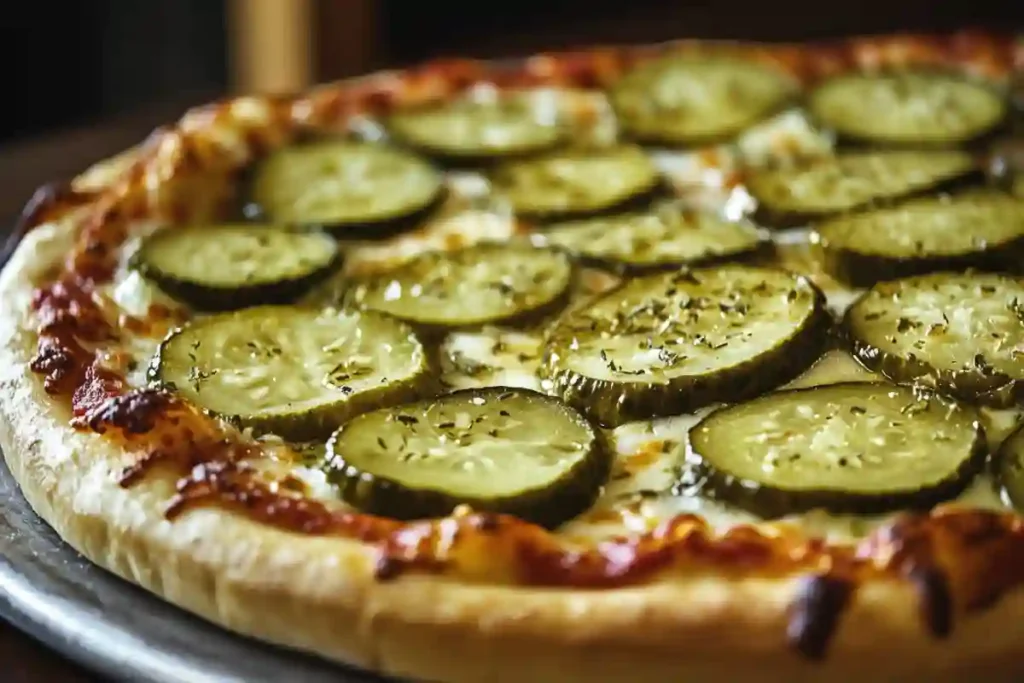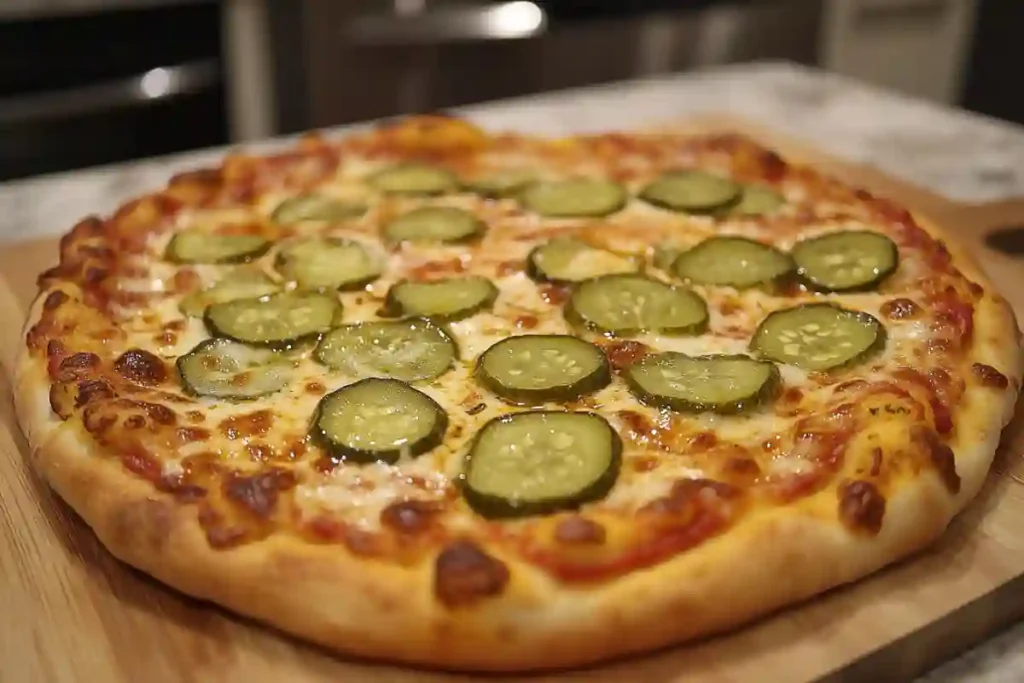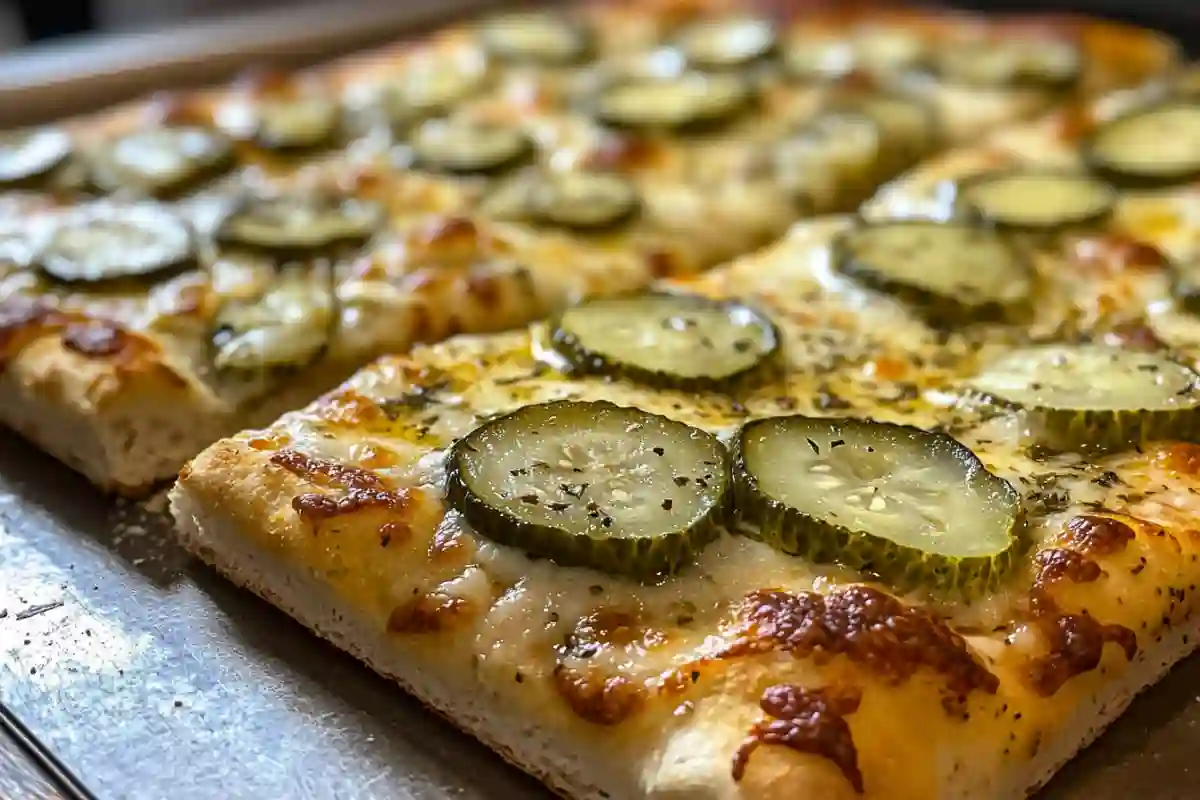Pickle pizza is a unique and increasingly popular dish that has left many food enthusiasts curious about its flavor. This article will dive deep into every aspect of pickle pizza’s taste, from its tangy topping to its delicious crust, to help you decide if it’s the right kind of pizza for your palate.
Introduction to Pickle Pizza: What to Expect?
Pickle pizza is a creative twist on the traditional pie, combining the zesty and salty taste of pickles with the familiar richness of pizza. This combination has sparked interest in the U.S. and beyond. But what does pickle pizza taste like? The answer might surprise you. Imagine a balance between tanginess, creaminess, and a slightly salty bite, all wrapped up in a comforting crust. For those who love pickles and pizza, this culinary experience is a must-try.

History and Rise of Pickle Pizza
Pickle pizza didn’t just happen overnight. It’s a product of culinary experimentation, starting in local pizzerias across the U.S. Pickles have always been a fan-favorite as a tangy side dish or a burger topping, but incorporating them into pizza brought a new, innovative twist that people loved. This section will look at how pickle pizza gained its fame and why it has stayed a trend.
- The Origins: The concept started as a local specialty in pizzerias that dared to step out of the traditional pizza box. It first became a sensation in parts of the Midwest and Northeast.
- Social Media Buzz: Platforms like Instagram and TikTok played a huge role in popularizing pickle pizza. Food influencers captured the essence of this unique pizza, making people eager to taste it for themselves.
- Flavor Combinations: Pickle pizza may feature white garlic sauce as the base, mozzarella cheese, and, of course, slices of dill pickle. The combination is simple yet delivers an unexpected flavor experience.
The Taste Profile of Pickle Pizza
So, what does pickle pizza taste like? Let’s break down the flavor experience.
Tangy, Salty, and Creamy: A Balancing Act
The first bite of pickle pizza introduces you to a robust blend of flavors. It’s all about balance. The salty tang of the pickles contrasts wonderfully with the creamy base sauce. Here’s a detailed breakdown:
- Tanginess: Pickles bring a tang that’s sharp yet enjoyable. This tanginess provides a refreshing contrast to the typical heaviness of pizza.
- Saltiness: Pickles are inherently salty, and when paired with mozzarella cheese, the saltiness intensifies slightly. However, the cheese also brings a creamy element that rounds out the flavor.
- Creamy Garlic Sauce: Unlike a traditional red sauce, many pickle pizzas use a white garlic sauce as the base. The sauce is rich, buttery, and perfectly complements the acidic pickle slices.
The Crust: A Familiar Foundation
The crust of a pickle pizza doesn’t stray far from traditional pizzas. It provides the chewiness and crunch needed to hold up the toppings while also balancing the strong flavors of pickles and cheese.
- Texture: The texture of the crust is crucial in pickle pizza. A well-baked crust provides a crisp base, supporting the soft toppings and enhancing the overall mouthfeel.
Layered Flavor Profiles
Pickle pizza combines several flavors that work harmoniously together, yet each element stands out on its own. The creamy garlic sauce, the mozzarella cheese, and the pickles each contribute to different layers of taste.
- Garlic Flavor: The garlic often used in the sauce gives a savory depth, balancing the sourness of the pickles.
- Herbs and Spices: Sometimes, herbs like dill and black pepper are added, enhancing the overall profile with additional spice and freshness.
The Unexpected Flavor Pairing: Why It Works
You might wonder why pickles work so well on pizza. The key is in balancing opposites. The acidity of pickles cuts through the creaminess of the cheese, making each bite vibrant and not overwhelmingly rich. The salty and sour notes bring an unexpected but welcome contrast, while the garlic sauce creates a savory foundation that ties all the flavors together.
- Contrast of Flavors: Similar to how pineapple offers sweetness on a Hawaiian pizza, pickles provide an acidic zing that keeps your taste buds intrigued.
- Umami Boost: The combination of pickles, cheese, and garlic also hits all the umami notes, creating a deeply satisfying flavor.
Who Will Love Pickle Pizza?
Pickle pizza is for those who enjoy the unusual in food—those who crave the mix of tangy and creamy flavors. Here are some reasons you might love it:
- Pickle Enthusiasts: If you love pickles on sandwiches or as a snack, this pizza will likely hit the spot.
- Fans of Unique Flavors: People who enjoy trying new twists on classic dishes will find pickle pizza particularly interesting.
- Acid Lovers: Those who love a bright, tangy flavor in their food will appreciate what the pickles bring to the table.
- Adventurous Eaters: Foodies who are always on the lookout for something new and different will be eager to try pickle pizza.
However, it’s worth noting that if you don’t enjoy the sharp tang of pickles, this pizza might not be your favorite. The pickle flavor is the star of the show, after all.
Variations of Pickle Pizza
Pickle pizza can vary based on regional preferences or the chef’s creativity. Here are a few common variations:
Spicy Pickle Pizza
- Spice Level: Some versions add a spicy kick, like hot sauce or jalapenos, creating a spicy-tangy combination. This addition complements the acidic pickles beautifully.
- Hot Sauce Drizzle: A drizzle of buffalo or hot sauce before serving can elevate the pizza and provide a satisfying heat.
Bacon Pickle Pizza
- Adding Smokiness: For those who want a little more, crispy bacon bits are sometimes added. The smokiness of the bacon pairs wonderfully with the creamy sauce and tangy pickles.
- Flavor Boost: The addition of bacon also adds a crunchy texture, which contrasts nicely with the smoothness of the cheese and pickles.
Gourmet Variations
- Artisanal Cheeses: Some gourmet versions swap mozzarella for other cheese varieties like gouda, gruyere, or even blue cheese, adding complexity to the flavor profile.
- Herbs and Garnishes: Dill and fresh parsley are often sprinkled on top to enhance the herby quality, while chives can add a mild onion-like flavor.
- Pickled Veggies: For a twist, other pickled vegetables like pickled onions or jalapenos are sometimes included to add extra layers of tanginess and spice.
Vegan Pickle Pizza
- Dairy-Free Cheese: Vegan cheese can be used in place of mozzarella to create a vegan-friendly version.
- Alternative Crusts: Gluten-free or cauliflower crusts are also an option, making the pizza accessible to those with dietary restrictions.
How Does Pickle Pizza Compare to Traditional Pizza?
Pickle pizza offers an entirely different taste experience compared to traditional tomato-based pizzas. Here’s a comparison of the key differences:
- Sauce Base: Traditional pizza often uses a tomato-based sauce, while pickle pizza leans towards a white garlic base.
- Flavor Intensity: Tomato sauce brings sweetness and acidity, while pickles provide a tangy, salty punch.
- Audience Appeal: While traditional pizzas have wide-ranging appeal, pickle pizza caters more to adventurous foodies and pickle lovers.
- Texture Differences: Traditional pizzas with tomato sauce have a different texture because of the moisture content in the sauce. Pickle pizza, with a creamier base, often results in a smoother texture.
Homemade Pickle Pizza Recipe
Making pickle pizza at home is surprisingly easy. Follow this simple recipe to recreate the experience:
Ingredients:
- Pizza dough (store-bought or homemade)
- Garlic white sauce
- Shredded mozzarella cheese
- Dill pickle slices
- Fresh dill (optional)
- Olive oil (for brushing the crust)
- Crushed red pepper flakes (optional for spice)
Instructions:
- Prepare the Dough: Roll out your pizza dough to your desired thickness.
- Apply the Sauce: Spread a generous layer of white garlic sauce across the dough.
- Add Toppings: Sprinkle mozzarella cheese evenly and add pickle slices.
- Bake: Bake in a preheated oven at 450°F (232°C) for about 12-15 minutes until the crust is golden.
- Garnish and Serve: Sprinkle fresh dill and, if desired, crushed red pepper flakes for a bit of heat. Brush the crust with olive oil for a nice sheen and added flavor.
Tips for Perfect Pickle Pizza
Choosing the Right Pickles
- Dill Pickles Work Best: Dill pickles are the most commonly used variety for pickle pizza because of their tartness and sharp flavor.
- Avoid Sweet Pickles: Sweet pickles might create a confusing taste when mixed with the garlic sauce and cheese.
- Pickle Thickness: Slice pickles thinly to avoid overpowering the other flavors. Thick slices may add too much moisture and make the pizza soggy.
Sauce Variations
- Try Ranch Sauce: For a different twist, use a ranch sauce instead of garlic sauce. It will add another creamy, herby layer.
- Spicy Garlic Sauce: Adding a bit of chili paste or crushed red pepper to the garlic sauce can introduce a subtle heat that balances well with the tang of the pickles.
Serving Suggestions
- Pair with Beer: The salty and tangy flavor of pickle pizza pairs exceptionally well with a cold beer.
- Side Dishes: Serve with a simple green salad to balance the richness of the pizza, or pair with garlic knots for an indulgent meal.
- Appetizer Ideas: Pickle pizza can be cut into smaller pieces and served as an appetizer at gatherings or parties for a quirky twist.
Nutritional Considerations of Pickle Pizza
Calorie Content
The calorie content of pickle pizza can vary depending on the ingredients used and the size of the slice. Generally, a slice of pickle pizza made with mozzarella cheese, garlic sauce, and pickles is comparable in calories to a standard cheese pizza but may be slightly higher due to the creamy sauce.
Sodium Levels
- High Sodium Content: Pickles are naturally high in sodium, which means pickle pizza can be saltier than traditional pizza. It’s worth noting this if you’re watching your sodium intake.
- Balancing Saltiness: Opt for low-sodium pickles or reduce the amount of cheese to make the pizza a bit less salty.
Customizing for Dietary Needs
- Gluten-Free Option: Use a gluten-free crust for those with gluten sensitivities or Celiac disease.
- Low-Fat Cheese: To reduce the fat content, consider using part-skim mozzarella or a lower-fat cheese alternative.
- Vegan Adaptations: Replace dairy cheese with a plant-based cheese to make the pizza vegan-friendly.
Health Benefits of Pickles
- Probiotics: Pickles can be a source of probiotics, especially if they are fermented naturally. These probiotics are great for gut health.
- Low in Calories: Pickles are relatively low in calories, making them a great addition for those wanting flavor without adding too many calories.
Pickle Pizza Around the World
Regional Variations in the United States
- Midwest: In the Midwest, pickle pizza is typically served with a thicker crust, and dill pickles are the standard. Some places even add ranch seasoning to the garlic base for extra Midwest flair.
- Northeast: In New York and surrounding areas, pickle pizza might feature a thinner crust with more gourmet touches like fresh herbs and artisanal cheeses.
- Southern States: In some Southern pizzerias, you might find spicy pickle pizzas that incorporate hot sauce or jalapenos, giving the pie a kick.
International Variations
- Canada: Canadian pizzerias often add extra toppings like bacon or smoked meat to create a rich, satisfying flavor combination that appeals to local tastes.
- Italy: Though not traditional, some artisanal pizzerias in Italy have begun experimenting with pickle pizza as part of a wave of unique, non-traditional toppings to appeal to tourists seeking a quirky twist.
- Australia: In Australia, pickle pizzas sometimes feature pickled beets or even pickled onions as an additional topping, adding a layer of sweetness and a different type of acidity.
Popularity and Cultural Impact of Pickle Pizza
Social Media Influence
Pickle pizza owes much of its fame to social media platforms. TikTok and Instagram, in particular, have been key in introducing pickle pizza to a wider audience. Viral videos showcasing the creation of pickle pizzas, the reactions of first-time tasters, and the bold flavor combinations have all contributed to its rise in popularity.
- Food Challenges: Many food influencers have taken on the challenge of trying pickle pizza live on camera, sparking interest and curiosity among viewers.
- Trendy Food: Much like other viral foods such as avocado toast or cronuts, pickle pizza has become a trendy item to seek out and share on social media.
Restaurant Menus and Events
- Limited-Time Offers: Many restaurants and pizzerias have added pickle pizza as a limited-time item, enticing customers with its novelty.
- Food Festivals: Pickle-themed food festivals, which have been growing in popularity, almost always include pickle pizza as a featured item. This exposure has helped solidify pickle pizza as a fun and quirky culinary option.
Frequently Asked Questions (FAQs)

1. Is Pickle Pizza a Good Option for Kids?
It depends on the child. Kids who already enjoy pickles might love pickle pizza, while those with simpler tastes may prefer traditional options.
2. Does Pickle Pizza Have a Strong Pickle Flavor?
Yes, pickle pizza has a noticeable pickle flavor. If you are not a fan of pickles, it might not be enjoyable for you.
3. What Kind of Pickles Should I Use?
Dill pickles are typically recommended due to their tangy and savory flavor profile.
4. Can I Make Pickle Pizza on a Gluten-Free Crust?
Absolutely. Use a gluten-free crust for those with dietary restrictions, and it will work just as well with the toppings.
5. What Type of Cheese Works Best for Pickle Pizza?
Mozzarella is the go-to choice, but you can experiment with other cheeses like gouda or cheddar for added flavor.
6. How Can I Store Leftover Pickle Pizza?
To store leftover pickle pizza, wrap it tightly in plastic wrap or store in an airtight container in the refrigerator for up to three days. Reheat in the oven to maintain the crispiness of the crust.
7. Can I Add Other Toppings to Pickle Pizza?
Yes, you can! Some popular additions include crispy bacon, hot sauce, or even pickled onions for extra flavor.
8. Can Pickle Pizza Be Made on a Grill?
Yes! Grilling pickle pizza adds a smoky flavor that complements the tanginess of the pickles. Preheat your grill to medium-high heat, and cook the pizza until the crust is crisp and the cheese is melted.
9. What Drinks Pair Well with Pickle Pizza?
A crisp lager or pilsner pairs perfectly with pickle pizza, as the beer’s lightness helps balance the tangy flavor. For non-alcoholic options, lemonade or a sparkling water with lemon works well.
Conclusion of : What does pickle pizza taste like?
What does pickle pizza taste like? The answer is a delightful mix of tangy, salty, and creamy flavors that create a unique pizza experience. Whether you’re a pickle enthusiast or simply looking for something new, pickle pizza offers a fun twist that’s worth trying. With its growing popularity, it’s clear that people are loving this quirky combination, and maybe you will too. Whether you try it at a local pizzeria, make it at home, or find it at a food festival, pickle pizza is sure to leave a lasting impression.
Related article : Pickle Pie Pizza: The Ultimate Savory Twist on Classic Pizza

